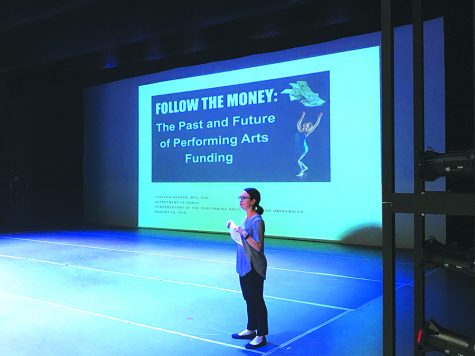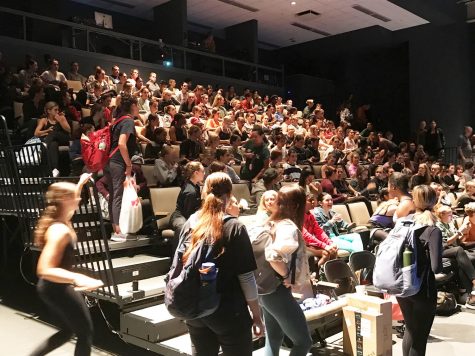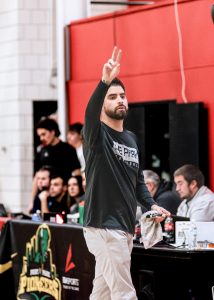Artists supported by the federal government
Dr. Hooper gives presentation on past and future of arts funding
September 4, 2019

Dr. Collen Hooper speaks about the history of arts funding to the student body in the GRW Performance Space in the Dance Complex.
Dozens of students sat packed together in the GRW Performance Space on Aug. 28. Instructions were given to make space for others pouring through the doors, and many still had to make do with the floor. All were there anticipating Dr. Colleen Hooper’s presentation on the past and future of their careers.
Hooper, assistant professor in the Conservatory of Performing Arts (COPA), has researched the topic of funding for artists since 2014 when she began her dissertation. Her interest led to her publishing an academic article entitled “‘Ballerinas on the Dole:’ Dance and the U.S. Comprehensive Employment Training Act (CETA), 1974–1982” in the Dance Research Journal in December 2017 and participating in a podcast about that article in October 2018.
Most recently, she is working on a book proposal on the subject and presented a full history of how artists once gained, and lost lucrative arts funding from the government.
Hooper started her talk by explaining the roots of public funding for the arts during the Great Depression. The Federal Theatre Project (FTP) employed actors, dancers and artists and gave them stable work throughout the period of economic turmoil, though it would only last until 1939. The foundations of FTP made possible 1970s formation of CETA, the main theme of Hooper’s lecture and research.
“It was basically a work program,” Hooper said. “So anybody who was unemployed during this time period was eligible to get a job through the government. Dancers and theatre artists were not supposed to be part of it, but somebody had the idea to include them, and then it became a movement all over the country.”
According to Hooper’s presentation, the government employed between 10,000 and 16,000 visual and performing artists. The employees worked standard hours of 35 hours per week, and their yearly salary was $10,000, which given inflation rates, roughly amounts to $40,000 in today’s currency. When Hooper asked how many students pursuing the arts would take that job offer, a significant number raised their hands.
Assistant Professor of English and coordinator of the literature program in the Department of Literary Arts and Social Justice Barbara Barrow helped coordinate the event with Hooper. To her, this event was important not only for students in the Conservatory but any member of the student body, faculty and staff.
“Currently we’re seeing dramatic cuts in funding and support to the arts and humanities, which is deeply troubling,” Barrow said. “Even if we are not professional artists ourselves, we all benefit from the arts and the kind of creative and flexible thinking they promote.”

While the duration of the presentation was around an hour, much time and effort went into scheduling Hooper’s talk. One of Hooper’s own students, senior dance major Chezney Douglas, introduced Hooper to the audience. Hooper was Douglas’ instructor for Dance History, and Douglas was adamant about Hooper’s ability to communicate about social justice issues and how they relate to artists.
“[Hooper] does a really good job of presenting it in a way that you know dancers and younger students who maybe aren’t as involved or…we just weren’t raised to have the respect for what’s going on in the nation because we don’t quite understand how it affects us because it does two-fold,” Douglas said. “Everything that happens there comes back at us. But she does such a good job at not dumbing it down but just making it more presentable for us. An easier pill to swallow for us to kind of understand it. Like hey, these things are happening, we have a role to play, like we can easily use our voice to help. She does a great job at informing us.”
Setting up the event also included thorough coordination with the Provost’s office.
“I received a course release last fall from the Provost’s office to do research, and from talking with the Provost John Pearson, he suggested that I do some type of public event to share my research with the community,” Hooper said. “And I worked with literary arts, school justice Professor Barbara Barrow, and we put this together and luckily we were able to get support from the Dance Department and from the theatre personnel because it’s a lot of work. But that was kind of the impetus for it, is that now faculty do receive some course release to do research.”
Barrow advised Hooper in how best to spread the word about the event and helped secure light refreshments via Barrow’s former position in the 2018-2019 academic year as a co-chair of the Campus Academic Resources Committee. According to Barrow, the committee “works to support and promote faculty research on campus.”
“This was a great opportunity for faculty and students to come together around a topic of shared interest and to engage in a rigorous and collegial discussion,” Barrow said. “I hope that we’ll see more of these events where faculty get the chance to share their research with students and to hear from students about issues that are important to them, both in and beyond the classroom.”



















Janet Lane • Sep 15, 2019 at 12:39 PM
Dr. Hooper should be applauded for her research and the ability to shed light on the need for continued support for the Arts and humanities.